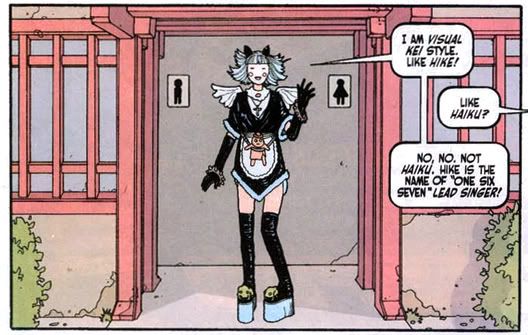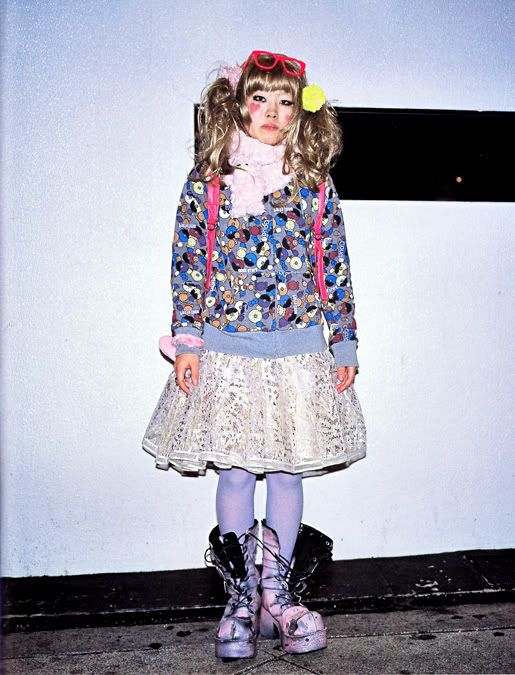 Tokyo Days Bangkok Nights
Tokyo Days Bangkok NightsPublisher: DC Comics
Writer: Jonathan Vankin
Art: Seth Fisher, Giuseppe Camuncoli and Shawn Martinbrough
First off, I'm not reviewing the Bangkok story that makes up the second half of this book. Why? It's totally arbitrary on my part. I bought this book to dig on all the drawings of Tokyo, a city I consider my spiritual home, not to read about Bangkok. I was briefly acquainted with a Georgia state trooper who fought professional mixed martial arts bouts and he loved Bangkok the one time he fought there and did the whole Thailand sex tourist thing in his free time. My mom might read this so I won't go into detail about the erotic activities he said he was into, but if they were only half-true (and that's probably all they were), Bangkok just isn't my place.
While I'm sure there's a lot more to Thailand than just the sex industry, I'm absolutely certain there's more to Japan than the over-the-top stereotypes bandied about in the US, on the Internet and in comics and movies. So here we go, taking a look at Vertigo/DC's Tokyo Days... minus Bangkok Nights.
Young American dude Steve is jonesing for the latest electronic doohickeys, so he does what any addicted tech-head would do—he jets off on a whim to Japan to visit Akihabara’s Electric City. High-tech gadgets aside, Steve’s totally unprepared for what he finds there. Dragged to a koban (police box) by some less-than-helpful Tokyo cops for the crime of “dialing while gaijin,” Steve’s rescued by a pink-haired girl named Makiko and spirited away for a whirlwind adventure involving incompetent yakuza thugs, a kidnapped visual-kei rocker, Harajuku's fashion scene and a food fight at a burger joint. You haven’t gone mad… you're not hallucinating... it's merely Steve's culture shock in communicabe form invading your brain cells... these things are happening right now, in real time. It’s Tokyo courtesy of writer Jonathan Vankin and artist Seth Fisher.
Their vision of Tokyo is a colorful mixture of practically every Japanese pop culture element circa the turn of the century. Makiko, also known as Maki, is a loopy high school girl with dreams of becoming a star like her rock idol Hike. Her purple-haired friend Mizumi seems doomed to a life as a flight attendant. Your average Japanese high school student tends to be overworked and stressed out, but Maki and Mizumi are a couple of trouble-making freaks, not the kind to be involved in school clubs, cram school and college entrance exams.
When the two rudderless girls set out so Mizumi can practice her English on foreigners, Maki stumbles across the hapless Steve. Maki is pretty much a wish-fulfillment figure—shrill and silly, wild and unpredictable, unbearably cute whether she’s in her sailor suit school uniform or her vinyl visual-kei rocker suit… and, of course, sexually aggressive. She represents the ever-popular Western fetishizing of the hot, hip young Japanese girl as human cartoon, completely out of control and irresistible. In fact, Maki never gives Steve the option of resistance-- she completely takes over his life, thus rendering Steve her more-than-willing victim. Former idol singer Hirosue Ryoko played just such a hyper-active candy confection/Japanophile wet dream in Luc Besson's Wasabi, and Roger Ebert panned her for it. Guess it works better in comic book form.

The comic book version.
But if Maki is an exaggeration or symbolic of Western objectification of Japanese high school girls—which is no less than an extension of their objectification in Japan itself—one is tempted to allow Vankin to get away with it because the story itself is so light-hearted and comical.
However, what Tokyo does by presenting the narrative from Steve's skewed point of view is make the Japanese seem wacky and weird, a kind of updated Oriental romantic exoticism filtered through the post-modern. Hello Kitty with a knife in her hand. And Steve is literally the only normal character in the story. It's a criticism also leveled at Lost in Translation, a movie I enjoyed but found similarly troubling. Lost in Translation accurately expresses the alienation a visitor can feel here in Japan, but it also reduces the country to a caricature of itself, something otherworldly for Scarlett Johansson to react to. Similarly, Tokyo captures the vibrancy of its eponymous megalopolis, but then doesn't balance its portrayal of fashion crazies, goofy gangsters and Keystone Kops.
While I certainly wouldn't go so far as to call Tokyo racist by any means-- I think it has a great deal of genuine affection for Maki and her friends, perhaps Vankin should have completely eliminated Steve as our masking character, our "in," and told the story from Maki's viewpoint, or Mizumi's. In that way it would've been a more immersive experience and not another one of those "dopey white people experience a bizarre, alien culture."
Instead, Tokyo's Japan becomes the Other in a very familiar process that really should have run its course, and the story itself presents a modern Japan of our Internet-skewed imaginations. More William Gibson-meets-Viz Comics-on-LSD than Donald Richie. As such, even with some of the disturbing subtext, it's a hilariously garish lampoon of the real thing, a bento box (if you will) of all the various Japanese pop culture trends all at once. The basic elements are truthful. These things exist, but when they're all we see via the media, we get a very dysfunctional view and Tokyo serves to further reinforce it when it could have gone for a deeper truth.
At one time there were insanely colorful fashionistas inhabiting Harajuku; it’s not Vankin’s fault Gwen Stefani chose to misappropriate, colonize and market a subculture that basically died out there circa 1998 and evolved into new forms, which you can still taste in any given issue of Fruits. And of course there is a yakuza, but they’re hardly as humorous as Vankin’s incompetent thugs, who owe as much to the Three Stooges as they do the Yamaguchi-gumi. And girls (and some boys) do dress up in crazy outfits to attend visual-kei concerts; but you’re more likely to see them doing the gosu-rori thing in petticoats and lacy frills than donning sci-fi vinyl like Maki's, however. But... I've seen people in vinyl here, too.

The real thing, courtesy the latest issue of Fruits, #141.
And Seth Fisher’s art is nothing short of phenomenal. He deprives his characters of certain humanizing traits (noses, for example) but compensates by giving them expressive eyes and mouths, by decking them out in specific costumes, and posing them in completely accurate Tokyo cityscapes. You could almost use his Harajuku as a walking guide to the area immediately outside the station, all the way down to the pedestrian bridge leading into Yoyogi Park. While certain elements are fictionalized, a single day spent walking around Ikebukuro or Akihabara would serve to authenticate Fisher’s settings. Tellingly, he lived full-time in Osaka and seemed to be on his way to becoming American comics' go-to guy for Japan-based adventure stories.
It's colorful and manic and perfectly in tune with the Tokyo I've visited so many times. Very tragic to lose an artist and a family man so young. When I first saw bits and pieces of this story, I really wanted to meet the guy.
Fast-paced, frenetic, completely over-the-top, if you don't take it as anything other than tongue in cheek, Tokyo makes a fine primer on Japanese pop culture as it stood around 2002. However, if you're interested in going deeper into the various subcultures and understanding them from a more organic viewpoint, I recommend Tokyo Schoolgirl Inferno by Patrick Macias and Izumi Evers, with hilarious paintings by Kazumi Nonaka. Nonaka's illustrations themselves are worth the cover price, but the text is a fun and informative historical overview of the various Tokyo style tribes, tracing their development over the years. Tokyo Look Book by anthropologist Philomena Keet, with gorgeous photographs by Yuri Manabe, is a more scholarly, but no less enjoyable report on the same phenomenon.
Both books feature interviews with people involved in Tokyo fashion culture, so you get their perspective rather than relying on some bland fictional effigy to fill you in. From there you can find your way around Tokyo on your own, discovering and illuminating a city that I find endlessly fascinating.

No comments:
Post a Comment